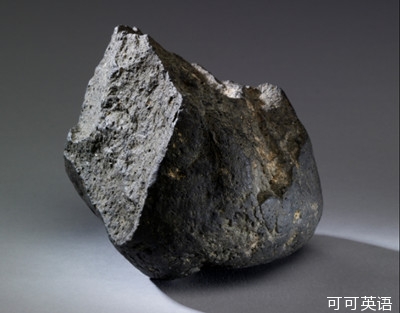002 : Olduvai Stone Chopping Tool
奧杜瓦伊石質切割工具
Olduvai stone chopping tool (made 1.8 million years ago) found in Olduvai Gorge, Tanzania, East Africa.
奧杜瓦伊(Olduvai)石質切割工具(180萬年前),出土于東非坦桑尼亞奧杜瓦伊(Olduvai)峽谷
Perhaps the best thing of all about being Director of the British Museum, and one that still gives me the most enormous thrill is that, now and then, I'm allowed to take some of the objects out of the cases and hold them.
作為大英博物館館長,大概最美好一件事便是我偶爾可以拿出展柜中的某些物品握在手中。我至今仍為之心潮澎湃。
And today I'm being allowed to hold something absolutely astonishing. I've got to admit that if any of us saw this just lying on the ground, we'd probably walk past it, but in fact it's the oldest object in the British Museum, and it was made nearly two million years ago, in Africa. It looks like a large, chipped grey cobble.
今天,我就被批準拿出一樣極其驚世駭俗的物品。我得承認,如果我們只是看到它毫不起眼地擺在地上,很可能就一帶而過了,但事實讓,它可是大英博物館最古老的展品。它來自于200萬年前的非洲大陸,看上去就像一塊人為切割過的灰色大卵石。我和博物學家兼廣播員大衛?阿滕伯勒爵士(Sir David Attenborough)是最近一次觸摸過它的人科動物。
"Holding this, I can feel what it was like to be out on the African savannahs, needing to cut flesh for example, needing to cut into a carcass, in order to get a meal."
“握著它,我便能感受到非洲大草原上的野外生活——為了一頓飯,要剔骨剜肉。”
This is one of the first things that humans ever consciously made. And holding it puts me directly in touch with them. In this history of the world that I'm trying to tell through 'things', this chipped stone from Africa - from modern Tanzania - is where it all begins.
這是人類自覺制作的首批工具之一,一拿起它,我就能感受到與祖先一脈相承的聯系。在這個以人造物為線索的世界簡史系列節目中,這件來自當今坦桑尼亞地區的非洲打制石器乃人類世界萬物之端。
I've come out of the front steps by the main door of the British Museum. One of the points of any museum is to allow you to travel through time, but our understanding of just how much time there is for us to travel through has expanded dramatically since the British Museum opened its doors in 1759. At that point, most of the visitors would probably have agreed that the world had begun in 4004 BC, to be precise at the very beginning of Sunday 23 October.
所有博物館的目標之一就是引領你穿越時間,然而,自1759年大英博物館開啟重門以來,我們時光之旅的界限便與日俱增。過去,也許大多參觀者的共識是世界開始于公元前4400年,更精確地說,是10月23日星期天的零點。
This astonishingly exact date had been calculated by the mathematically-minded clergyman Archbishop Ussher, who preached just down the road in Lincoln's Inn. Ussher had carefully trawled the Bible totting up the lifespan of everyone descended from Adam and Eve to reach his date but, as you and I know, we don't now celebrate 23 October as Start the World Day and that's because, in the last couple of centuries, archaeologists, geologists and museum curators have steadily been pushing back the chronology of human history - back from Archbishop Ussher's six thousand years to an almost unimaginable two million.
這一精確得不可思議的時間是由一位頗具數學頭腦的神職人員厄舍(Ussher)計算出來的,他布道的地點就在本街的林肯律師學院。他一絲不茍地查閱了《圣經》,統計亞當夏娃所有后裔的壽命才得出這一結果,但就我們所知,沒有人慶祝10月23號的“世界開始日”,因為幾個世紀以來,考古學家、地質學家以及博物館館長一直在把人類歷史紀年不斷推延——從厄舍大主教的6000年到難以置信的200萬年。
So if the scientists have been suggesting that Adam and Eve no longer stood at the beginning of human time in the Garden of Eden in 4004 BC, who did? And where? There are many theories, but no conclusive answers and certainly no conclusive date until 1931, when a young archaeologist called Louis Leakey set off on a British Museum-sponsored expedition bound for Africa.
既然科學家推測公元前4400年伊甸園中的亞當夏娃已非人類的先驅,那么彼何人斯,彼何處斯?曾有過許多理論,但直至1931年,有一位名為路易斯?李基(Louis Leaky)的青年考古學家在大英博物館的資助下遠征非洲,他的考古發現為這個問題做出了明確的解答。












